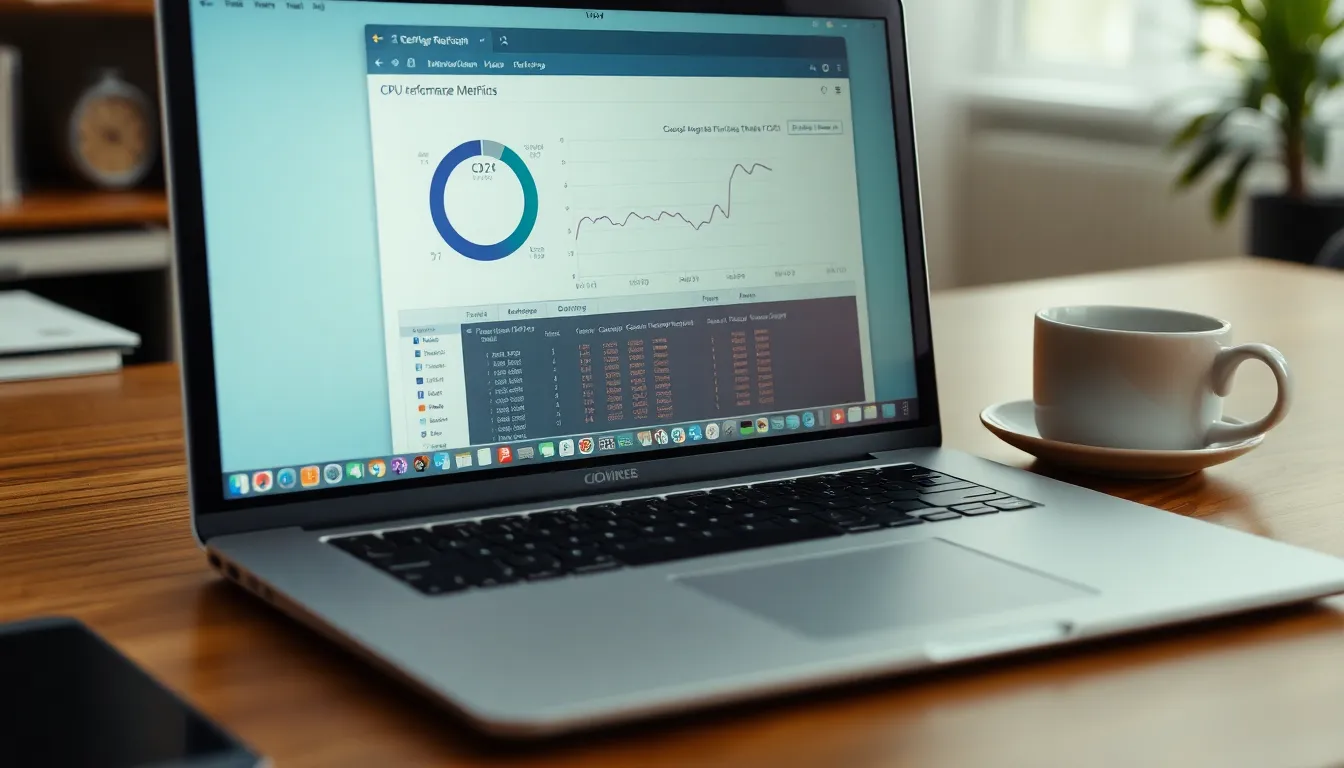In a world where laptops are as essential as morning coffee, understanding laptop specifications can feel like deciphering ancient hieroglyphs. With so many options out there, how does one choose the perfect machine? Fear not, tech warriors! This guide will break down the specs that matter, so you can avoid the dreaded buyer’s remorse and find a laptop that won’t let you down during your next Netflix binge or Zoom call.
Table of Contents
ToggleUnderstanding Laptop Specifications
Understanding laptop specifications aids in making informed choices. Essential components determine performance, usability, and overall experience.
Key Components of Laptop Specifications
Processor type and speed significantly influence a laptop’s performance. RAM capacity affects multitasking capabilities; 8 GB is standard for casual users, while 16 GB suits more demanding tasks. Storage options include SSDs for speed and HDDs for capacity. Display resolution also matters; Full HD (1920×1080) offers clarity for most applications, while higher resolutions enhance visual quality. Battery life duration, measured in hours, indicates how long a laptop can function unplugged.
Importance of Laptop Specifications
Laptop specifications guide users in selecting devices for specific needs. Knowing these details can prevent dissatisfaction and ensure the right fit for tasks such as gaming, graphic design, or office work. Quality specifications often reflect a laptop’s longevity and reliability. Value features, like lightweight design and durability, can enhance user experience. Prioritizing the right specifications helps users avoid spending on unnecessary features.
Central Processing Unit (CPU)

The CPU is the heart of any laptop, determining overall performance and responsiveness. It plays a crucial role in processing instructions and executing tasks effectively.
Types of CPUs
CPUs primarily fall into two categories: Intel and AMD. Intel processors, such as Core i3, i5, and i7, are widely known for their reliability and strong performance. AMD offers Ryzen series processors, which often provide excellent multi-core performance for gaming and productivity tasks. Both companies offer various generations of chips, improving efficiency and speed over time. Integrating features like built-in graphics capabilities, these processors suit a range of user needs, from casual browsing to intensive gaming or graphic design. Users should consider specific CPU models and their targeted tasks to maximize performance.
Performance Metrics
Evaluating performance metrics is essential when choosing a CPU. Clock speed, measured in gigahertz (GHz), indicates how many instructions the processor can execute per second. A higher clock speed typically results in better performance, although core count also plays a vital role. Dual-core and quad-core CPUs handle multitasking more effectively than single-core models. Benchmarks, derived from real-world tests, provide insights into a CPU’s capabilities. Applications like Cinebench and PassMark help users compare processors directly. Prioritize these metrics based on intended use to ensure a suitable processor for everyday tasks or demanding applications.
Memory and Storage
Memory and storage play critical roles in determining a laptop’s performance. Understanding these components helps users choose devices that support their specific needs.
RAM Specifications
RAM, or Random Access Memory, affects multitasking capabilities. Standard options include 8 GB for average users and 16 GB for gamers or professionals. High-end laptops may offer up to 32 GB for demanding applications. Faster RAM types like DDR4 often enhance system responsiveness. Performance can degrade when multiple applications run concurrently, as insufficient RAM forces the system to rely on slower storage. Evaluating a laptop’s RAM capacity ensures smooth operation during multiple tasks or intensive workloads.
Storage Options
Storage options significantly influence a laptop’s speed and capacity. Solid State Drives (SSDs) provide faster data access than traditional Hard Disk Drives (HDDs). Most laptops offer SSDs, ranging from 256 GB to 2 TB in size. Users focused on media-heavy workflows may require larger SSDs for efficiency. HDDs typically offer larger capacities, from 1 TB to 4 TB, at lower costs. Hybrid storage solutions combine both SSD and HDD advantages, enabling faster boot and load times while providing substantial storage space. Choosing the right storage type affects overall usability and performance.
Graphics Processing Unit (GPU)
The Graphics Processing Unit significantly impacts overall laptop performance, especially for tasks involving visual content. Understanding the type of GPU is essential for users who engage in gaming, graphic design, or video editing.
Integrated vs. Dedicated Graphics
Integrated graphics come built into the CPU and suffice for everyday tasks like browsing and streaming. These GPUs share system memory and are power-efficient, making them suitable for basic use. Conversely, dedicated graphics cards exist as separate components, offering superior performance through dedicated memory. They excel in demanding applications such as 3D rendering and high-resolution gaming. Users requiring high graphic fidelity should prioritize laptops with dedicated GPUs for enhanced performance.
Effects on Performance
Graphics Processing Units directly influence gaming and content creation experiences. A powerful GPU enables smooth frame rates and high visual fidelity, essential for immersive gameplay. Conversely, a less capable GPU may struggle with rendering complex graphics, leading to choppy performance. Benchmarks, such as 3DMark and Unigine Heaven, help quantify GPU capabilities, comparing performance across models. Selecting a laptop with a robust GPU enhances visual output, making it crucial for graphic-intensive tasks.
Display Quality
Display quality plays a vital role in enhancing user experience across different tasks. Key specifications like screen resolution, refresh rate, and color accuracy significantly impact visuals and usability.
Screen Resolution
Screen resolution determines the clarity and detail of images and text. Common options include Full HD (1920 x 1080), Quad HD (2560 x 1440), and 4K Ultra HD (3840 x 2160). Higher resolutions provide sharper visuals, making them ideal for graphic design, video editing, and gaming. Laptops featuring 4K displays offer the highest clarity, essential for tasks that demand precision. When selecting a laptop, considering screen resolution aligns with the intended use, ensuring optimal performance for specific applications.
Refresh Rate and Color Accuracy
Refresh rate influences how smooth motion appears on screen. Standard refresh rates are 60Hz, while gaming and professional laptops often feature 120Hz or higher for fluid visuals. Higher refresh rates minimize motion blur, benefiting gaming and video playback experiences. Color accuracy is equally crucial for tasks involving graphics and photography. Displays with wider color gamuts enhance the vibrancy and realism of images. A laptop with an IPS (In-Plane Switching) panel typically ensures better color reproduction and viewing angles. Prioritizing both refresh rate and color accuracy leads to a more engaging and visually appealing experience.
Battery Life and Performance
Battery life significantly impacts overall laptop performance. Many users prioritize longevity, especially when using devices on the go.
Factors Affecting Battery Life
Battery life hinges on various factors. Screen brightness plays a crucial role; higher brightness consumes more power. Running multiple applications simultaneously also drains the battery faster. Additionally, the types of tasks being performed matter; gaming or video editing necessitates more energy than simple word processing. Battery technology influences performance too. Lithium-ion batteries are common, offering a good mix of capacity and longevity. Regular software updates can enhance battery efficiency, optimizing power management. Understanding these factors helps users adjust their usage for optimal battery performance.
Evaluating Battery Performance
Evaluating battery performance requires specific metrics. Users should consider watt-hour (Wh) ratings, indicating the total energy capacity. Brands often disclose battery life estimates in hours; real-world usage may differ from these claims. Testing under different conditions can provide an accurate reflection of battery longevity. Battery health metrics are also essential; checking for wear levels can inform users when a battery replacement is necessary. Utilizing battery-saving modes within the operating system can extend usage time. Examining user reviews and benchmarking tools offers additional insights into a laptop’s battery performance, enabling informed purchasing decisions.
Navigating the world of laptop specifications can seem daunting but understanding the key components makes all the difference. By focusing on the processor type RAM capacity storage options display quality and battery life users can make informed decisions that align with their needs. Prioritizing these specifications not only enhances performance but also ensures a satisfying user experience.
Investing time in evaluating these factors leads to better choices and ultimately a laptop that meets specific requirements whether for work gaming or creative tasks. With the right knowledge users are empowered to select a reliable machine that will serve them well for years to come.





